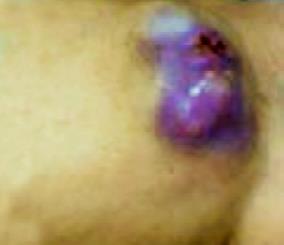Port Site Metastasis in Laparoscopic Surgery
In the early experience of laparoscopic colectomy for cancer, a few reports described immediate tumor recurrence at the laparoscopic incision sites, referred to as port-site recurrences. It was hypothesized such early cancer recurrence happened after laparoscopy due to tumor shedding and/or accelerated tumor growth, secondary to the presence of gas in the peritoneal cavity. However, multiple reviews have indicated that this is not the case. In one such study, which included over 2600 cases, the rate of port site recurrence was approximately 1 percent, which is similar to that noted in open colorectal surgery. It is not currently believed that laparoscopic colectomy is associated with early wound recurrences.

Portside metastasis after laparoscopic surgery
Port site implantation was a concern in the early period but it has been shown now that it can be prevented by:
• Proper protection of port site while delivering the specimen. (Endobags® and pouches).
• Avoid squeezing of the specimen by taking a liberal incision.
• Thorough wash to the wound, 5FU solution irrigation of all ports.
• Slow release of pneumo-peritoneum.
• Lap-lift technique
The cost can be brought down by either doing a hand-sewn anastomosis through the specimen delivery site or use of conventional stapler for extra-corporeal stapled anastomosis. Minimal use of disposable ports and instruments can further cut down the cost. The use of ultrasonic energy source in the form of harmonic shears (Ethicon® and USSC®) has added to the cost of lap surgery.
The two burning issues are port site metastasis in malignancies and cost factor due to the use of endostaplers. As mentioned earlier for a benign condition like rectal prolapse, adenomas, rectal polyposis and inflammatory condition like tuberculosis, ulcerative colitis, simple diverticulitis, and laparoscopic surgery offers a patient-friendly technique. Crohn's though not very common in India, but laparoscopy can be offered for the diagnosis, lymph node sampling, and curative resection. Ileocecal tuberculosis is commonly seen in our country and it is a good option to offer the benefits of laparoscopy to these patients whenever surgery is indicated. Incidental colonic resection is unlikely to help the laparoscopic surgeon team in mastering the techniques. The reduction of OT time due to better coordination and cost-benefit to patients can only be offered by repetitive performances. A dedicated team effort will surely bring this specialty under the umbrella of minimal access surgery as has happened in the western world.
In the early experience of laparoscopic colectomy for cancer, a few reports described immediate tumor recurrence at the laparoscopic incision sites, referred to as port-site recurrences. It was hypothesized such early cancer recurrence happened after laparoscopy due to tumor shedding and/or accelerated tumor growth, secondary to the presence of gas in the peritoneal cavity. However, multiple reviews have indicated that this is not the case. In one such study, which included over 2600 cases, the rate of port site recurrence was approximately 1 percent, which is similar to that noted in open colorectal surgery. It is not currently believed that laparoscopic colectomy is associated with early wound recurrences.

Portside metastasis after laparoscopic surgery
Port site implantation was a concern in the early period but it has been shown now that it can be prevented by:
• Proper protection of port site while delivering the specimen. (Endobags® and pouches).
• Avoid squeezing of the specimen by taking a liberal incision.
• Thorough wash to the wound, 5FU solution irrigation of all ports.
• Slow release of pneumo-peritoneum.
• Lap-lift technique
The cost can be brought down by either doing a hand-sewn anastomosis through the specimen delivery site or use of conventional stapler for extra-corporeal stapled anastomosis. Minimal use of disposable ports and instruments can further cut down the cost. The use of ultrasonic energy source in the form of harmonic shears (Ethicon® and USSC®) has added to the cost of lap surgery.
The two burning issues are port site metastasis in malignancies and cost factor due to the use of endostaplers. As mentioned earlier for a benign condition like rectal prolapse, adenomas, rectal polyposis and inflammatory condition like tuberculosis, ulcerative colitis, simple diverticulitis, and laparoscopic surgery offers a patient-friendly technique. Crohn's though not very common in India, but laparoscopy can be offered for the diagnosis, lymph node sampling, and curative resection. Ileocecal tuberculosis is commonly seen in our country and it is a good option to offer the benefits of laparoscopy to these patients whenever surgery is indicated. Incidental colonic resection is unlikely to help the laparoscopic surgeon team in mastering the techniques. The reduction of OT time due to better coordination and cost-benefit to patients can only be offered by repetitive performances. A dedicated team effort will surely bring this specialty under the umbrella of minimal access surgery as has happened in the western world.





